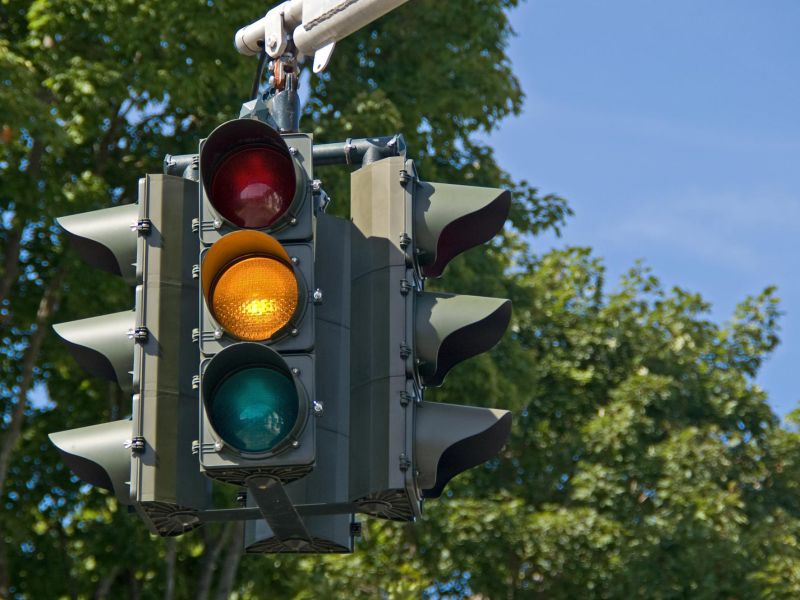
— Miscellaneous Traffic Offenses, Reckless Driving, Traffic Resources
Is It Illegal To Run A Yellow Light In Virginia?
A yellow or amber light alerts drivers that the traffic signal is about to turn red, allowing traffic to begin traveling in other directions. Motorists commonly see the yellow light and speed up to make it through the intersection before the light turns red. Some Virginia drivers may be surprised to learn that those who have not entered the intersection are supposed to stop for yellow lights unless stopping would cause unsafe driving conditions. Anyone who has already entered the intersection when a light turns yellow should proceed unless other vehicles or pedestrians are in their path. If you have questions like, Is it illegal to run a yellow light? Driving Defense Law may be able to help. Call (757) 929-0335 today to schedule your free consultation.
Is it Illegal To Run a Yellow Light?
The legality of running yellow lights is complex, and there is no straightforward answer. Virginia traffic laws require vehicles to stop at yellow lights unless they have already crossed the line and entered the intersection or crosswalk at the time the light turns yellow. However, the regulations also state that the driver should proceed with caution if stopping is not reasonably safe.
Potential stopping hazards may be rainy, snowy, or icy conditions, or the proximity of other cars following closely behind. Stopping suddenly at a yellow light could cause a rear-end traffic accident.
What Does a Yellow Light Mean?
Not every yellow traffic light means the same thing. Understanding the subtle differences can help keep motorists safe and help them avoid traffic tickets. A ticket issued for failure to obey traffic signals can result in a four-point moving traffic violation. Four points can cause insurance rates to increase or driver’s license suspension, depending on the motorist’s Virginia driving record.
- A solid yellow light is a warning that the light will turn red in between three and six seconds, and drivers should stop if they can do so safely.
- A flashing yellow light means drivers can proceed using caution and after checking to be sure that it is safe.
- A yellow arrow light is for making turns and a warning that the turning light is turning red.
- A flashing yellow arrow means drivers can legally make left-hand turns after yielding to oncoming traffic; if there is a pedestrian crosswalk, drivers turning left must yield to any pedestrians making their crossing as well.
A yellow light, whether steady, flashing, or an arrow, means that motorists approaching the light should be careful. Speeding up when faced with a yellow light in hopes of clearing the intersection before the traffic signal turns red is not using caution and causes unnecessary risks of collisions. An attorney at Driving Defense Law may be able to help if you received a traffic ticket for running a yellow light.
Understanding Other Traffic Lights
Traffic lights are essential traffic control and safety devices. The regulations governing traffic signals help control the flow of traffic and keep the roads safer. Understanding the laws regarding each light is crucial to avoiding both car crashes and legal trouble.
- Fixed red traffic lights alert motorists that traffic must stop and remain stopped until the light turns green.
- Drivers should treat flashing red lights as stop signs and stop to look both ways before proceeding.
- Green traffic lights indicate that traffic may proceed through the intersection as long as the light remains green.
- A steady yellow light alerts motorists that the light is about to turn red, and traffic will begin flowing in a different direction.
- A flashing yellow light means traffic may come from the other direction, that those drivers have the right-of-way, and motorists must proceed with caution.
When approaching out-of-service traffic lights, everyone should proceed as if there is a four-way stop sign and follow right-of-way laws.
Stop or Go: What Do You Do at Yellow Lights?
Yellow lights are a caution signal, warning motorists that the light governing their lane of travel is to turn red. Generally, those who have not already entered the intersection or crosswalk must stop. However, when coming to a quick and sudden stop is not reasonably safe, such as when the surface of the roadway is wet and slippery, drivers facing a yellow light may continue through the intersection cautiously. Speeding up to “beat” yellow lights is unlawful and could result in a traffic citation if a police officer is present.
Can I Ever Cross That Stop Line if the Light Is Yellow?
When the motorist cannot safely come to a stop after the light turns yellow, they may carefully continue through the intersection. The driver must remain alert for other vehicles, bicycles, and pedestrians to avoid causing a collision.
What if I Have Crossed the Stop Line?
When drivers have crossed the line when the traffic light turns yellow, they may proceed legally through the intersection. According to the Code of Virginia § 46.2-833, motorists shall continue driving until they clear the crossway.
Yellow Light Timing and Avoiding the Yellow Trap
Knowing whether to stop or proceed through an intersection when the light turns yellow can be stressful and confusing. Red light cameras can often exacerbate drivers’ nervousness. Yellow light timing refers to the duration of the yellow traffic signal before it turns red. Failing to adhere to stop signs or running red lights are significant causes of severe or fatal car crashes. Therefore, when the Virginia Department of Transportation VDOT installs new traffic lights, they consider many variables, such as the intersection layout and speed limit.
Yellow light traps can increase the risks of auto collisions significantly. These “traps” involve motorists receiving a yellow turning signal and assuming the oncoming traffic also has a yellow light and will proceed with caution. In a yellow light trap, however, the oncoming traffic has a green light, and vehicles may collide unless one stops in time.
Schedule a Consultation With a Virginia Traffic Law Attorney
Traffic signals control many roads and highways in Virginia, and speeding through a yellow light or running a red light is unfortunately a common infraction. While the action is typical, failing to adhere to traffic light laws creates a serious traffic hazard, putting drivers at risk of car crashes. When a law enforcement officer is present, the action can also mean receiving a ticket for a four-point moving violation. After an accident or ticket, many do an internet search, asking, Is it illegal to run a yellow light? There is no simple answer, and whether running a yellow light is illegal in your instance will depend on the specifics of your particular case. Call a traffic lawyer in Virginia at Driving Defense Law at (757) 929-0335 for more information or to schedule a free case evaluation.

